A Comparative Analysis of Seaports in Terms of the Development of Maritime Tourism in the Area of the Baltic Sea
Abstract
:1. Introduction
2. Maritime Tourism
2.1. Maritime Tourist Market
- Permanent, located in a region that is served all year round due to resilient demand (with high/low periods) and stable weather conditions,
- Seasonal, serving the periodic market potential in periods with good weather conditions, in the so-called peak seasons,
- Routes with a change of location, between permanent or seasonal markets, where very often the voyage is in one direction only, or with a change of next port destinations.
- Market circumstances and requirements, such as seasonality of demand, the optimal duration of the voyage, a balance between sailing time and time spent on land, the existence of sights, and overall guest satisfaction,
- Purely operational considerations such as mooring capacity and navigability in ports, distance between ports, and synchronization with air transfers,
- Competitiveness of the market, i.e., the location and capacity of competing vessels, the configuration of existing cruise services and routes, and the existing structure of the market.
2.2. Key Aspects and Effects of Sea Tourism
2.3. The Offer and Attractiveness of Parts and Port Cities
- The degree to which the port is well situated in relation to popular cruise routes, i.e., the attractiveness of the port in terms of its geographical location,
- The tourist attractiveness of a given region. It is determined primarily by the characteristics of the area (climate, socio-cultural, and/or natural factors or proximity to tourist attractions), with the port industry and stakeholders having only a secondary impact, i.e., enhancing “tourist-friendliness” through accessibility information and multilingualism,
- The accessibility of the destination/region, proximity to an airport with air links to source markets, a railway station with good connections, and access to highways that support the increasingly popular “drive and cruise” concept may determine the potential of the port in terms of handling turnover or just transit,
- Port infrastructure and services, with different types of equipment expected from transit ports and ports handling traffic,
- Harbor dues, which vary according to port, ship size, and country, etc.
3. Sea Tourism in the Area of the Baltic Sea
3.1. Location and Characteristics of the Baltic Sea
- Historical similarities,
- Cultural make-up characteristics only for this group (material and intellectual culture),
- Geographical territorial integrity,
- The presence of certain similar features in the economy,
- Close economic, social and other internal ties,
- Cooperation in regional international organizations,
- Regional identity developed to varying degrees.
3.2. Passenger Shipping Connections of Baltic Ports
- Green: Warnemünde → Stockholm → Gotland → Gdynia → Copenhagen → Warnemünde, an 8-day route on an AIDAdiva ship.The same ship also covers a short route to Gdynia and Copenhagen in 5 days: Warnemünde → Stockholm → Gotland → Warnemünde.
- Pink: Kiel → Bornholm → Gdynia → Kiel, a 5-day route on an MSC ship the MSC Fantasia.
- Purple: Warnemünde → Gdynia → Klaipeda → Riga → Tallinn → Helsinki → Stockholm → Copenhagen → Karlskrona → Warnemünde, a 12-day route on an MSC Poesia ship.The same ship sometimes ends up in Copenhagen within 10 days: Warnemünde → Gdynia → Klaipeda → Riga → Tallinn → Helsinki → Stockholm → Copenhagen.
- Green: Stockholm → Helsinki → Kotka → Gotland → Tallinn → Riga → Klaipeda → Gdynia → Warnemünde → Kiel → Copenhagen, an 11-day route on the Norwegian Dawn; in this case, the cruise starts in Stockholm and ends in Copenhagen.
- Pink: Southampton → Oslo → Copenhagen → Tallinn → Stockholm → Skagen → Southampton, a 13-days route on the Celebrity Silhouette.
- Purple: Copenhagen → Gotland → Riga → Helsinki → Stockholm → Warnemünde → Copenhagen, 11-days route on the Nieuw Statendam.
- Green: Kiel → Stockholm → Gotland → Tallinn → Helsinki → Riga → Kiel, a 10-day route on the Costa Fascinosa.
- Pink: Southampton → Bornholm → Gotland → Stockholm → Tallinn → Riga → Klaipeda → Gdańsk → Copenhagen, a 15-day route on the Island Princess ship.
- Purple: Southampton → Gdańsk → Gotland → Helsinki → Tallinn → Stockholm → Warnemünde → Aarhus → Copenhagen → Kristiansand → Southampton, a 15-day route on the SkyPrincess.
4. Prospects for the Development of Sea Tourism
4.1. Baltic in Statistics
4.2. Directions of Development of Maritime Tourism in the Baltic Sea Region
- Western, including connections: Denmark–Sweden, Denmark–Norway, Denmark–Germany, Germany–Sweden, and Norway–Germany,
- Eastern, including connections: Sweden–Finland, Sweden–Estonia, Finland–Estonia, and Finland–Russia,
- Central, including connections: Poland–Sweden, Latvia–Lithuania, Lithuania–Germany, and Latvia–Finland.
5. Summary and Final Conclusions
Author Contributions
Funding
Institutional Review Board Statement
Informed Consent Statement
Data Availability Statement
Conflicts of Interest
References
- Martínez Vázquez, R.M.; Milán García, J.; De Pablo Valenciano, J. Analysis and Trends of Global Research on Nautical, Maritime and Marine Tourism. J. Mar. Sci. Eng. 2021, 9, 93. [Google Scholar] [CrossRef]
- Kizielewicz, J. Theoretical Considerations on Understanding of the Phenomenon of Maritime Tourism in Poland and the World. Zesz. Nauk. Akad. Morska Szczecinie 2012, 31, 108–116. [Google Scholar]
- Remer, M.; Liu, J. International Tourism in the Arctic under COVID-19: A Telecoupling Analysis of Iceland. Sustainability 2022, 14, 15237. [Google Scholar] [CrossRef]
- Diakomihalis, M.N. Greek Maritime Tourism: Evolution, Structures and Prospects. Marit. Transp. Greek Paradigm 2007, 21, 419–455. [Google Scholar] [CrossRef]
- Fatima, N.; Akhtar, M. Maritime Tourism: Global Success Stories and the Case of Pakistan. Polaris-J. Marit. Res. 2021, 1–29. [Google Scholar] [CrossRef]
- Sinulingga, A.A.; Asri, S.; Trisni, S. The Thought of Developing Halal Maritime Tourism Destination Towards Indonesia’s Vision as a World Maritime Axis. J. PIR Power Int. Relat. 2018, 2, 103–113. [Google Scholar] [CrossRef]
- Kizielewicz, J. Cruise Ship Tourism—A Case Study Poland. Sci. J. Marit. Univ. Szczec. 2013, 35, 65–75. [Google Scholar]
- Ito, H.; Hanaoka, S.; Kawasaki, T. The Cruise Industry and the COVID-19 Outbreak. Transp. Res. Interdiscip. Perspect. 2020, 5, 100136. [Google Scholar] [CrossRef]
- Pallis, T. Cruise Shipping and Urban Development. In International Transport Forum Discussion Papers; OECD Publishing: Paris, France, 2015. [Google Scholar] [CrossRef]
- CLIA. CLIA 2019 Cruise Trends & Industry Outlook; CLIA: Washington, DC, USA, 2019. [Google Scholar]
- CLIA. CLIA 2020 Cruise Trends & Industry Outlook; CLIA: Washington, DC, USA, 2020. [Google Scholar]
- Rodrigue, J.-P.; Notteboom, T. The Geography of Cruises: Itineraries, Not Destinations. Appl. Geogr. 2013, 38, 31–42. [Google Scholar] [CrossRef]
- Pikner, T.; Piwowarczyk, J.; Ruskule, A.; Printsmann, A.; Veidemane, K.; Zaucha, J.; Vinogradovs, I.; Palang, H. Sociocultural Dimension of Land–Sea Interactions in Maritime Spatial Planning: Three Case Studies in the Baltic Sea Region. Sustainability 2022, 14, 2194. [Google Scholar] [CrossRef]
- Charlier, J. The Seasonal Factor in the Geography of Cruise Shipping. Dock Harb. Auth. 1999, 79, 214–219. [Google Scholar]
- Ivče, R.; Paparic, D.; Zekic, A.; Škapul, M. Effect of Antifouling Paints and Nautical Tourism on the Sustainability of Marine Environment in the Case of the Village Ports of a Small Island. TransNav Int. J. Mar. Navig. Saf. Sea Transp. 2020, 14, 701–707. [Google Scholar] [CrossRef]
- Gou, Y.; Wang, C. Identification and Differentiation of the Hierarchical Structure of the Caribbean Cruise Shipping Network Based on Route Organization. Sustainability 2022, 14, 9448. [Google Scholar] [CrossRef]
- Łukasik, Z.; Kuśmińska-Fijałkowska, A.; Olszańska, S.; Roman, M. Analysis and Evaluation of the Planning Process in a Transport Company. Zesz. Nauk. Transp. Politech. Śląska 2022, 115, 35–51. [Google Scholar] [CrossRef]
- Niavis, S.; Vaggelas, G. An Empirical Model for Assessing the Effect of Ports’ and Hinterlands’ Characteristics on Homeports’ Potential. Marit. Bus. Rev. 2016, 1, 186–207. [Google Scholar] [CrossRef]
- Krile, S.; Maiorov, N.; Fetisov, V. Modernization of the Infrastructure of Marine Passenger Port Based on Synthesis of the Structure and Forecasting Development. Sustainability 2021, 13, 3869. [Google Scholar] [CrossRef]
- Chaure, M.R.; Gudmestad, O.T. Effectiveness of the Polar Code Training of Cruise Liner Crew for Evacuation in the Arctic and Antarctic. TransNav Int. J. Mar. Navig. Saf. Sea Transp. 2020, 14, 923–928. [Google Scholar] [CrossRef]
- Olaniyi, E.O.; Prause, G.; Gerasimova, V.; Inkinen, T. Clean Cruise Shipping: Experience from the BSR. Sustainability 2022, 14, 5002. [Google Scholar] [CrossRef]
- Brida, J.G.; Zapata-Aguirre, S. Cruise Tourism: Economic, Socio-Cultural and Environmental Impacts. Int. J. Leis. Tour. Mark. 2010, 1, 205–226. [Google Scholar] [CrossRef]
- Zekic, A.; Ivče, R.; Radonja, R. Emission Inventory of Ships Calling at the Port of Dubrovnik. TransNav Int. J. Mar. Navig. Saf. Sea Transp. 2022, 16, 219–223. [Google Scholar] [CrossRef]
- Winchenbach, A.; Hanna, P.; Miller, G. Constructing Identity in Marine Tourism Diversification. Ann. Tour. Res. 2022, 95, 103441. [Google Scholar] [CrossRef]
- Lekakou, M.; Pallis, A.; Vaggelas, G. Which Homeport in Europe: The Cruise Industry’s Selection Criteria. Tour. Int. Multidiscip. J. Tour. 2009, 4, 215–240. [Google Scholar]
- Deely, J.; Hynes, S.; Cawley, M.; Hogan, S. Modelling Domestic Marine and Coastal Tourism Demand Using Logit and Travel Cost Count Models. Econ. Anal. Policy 2023, 77, 123–136. [Google Scholar] [CrossRef]
- Liebuvienė, J.; Čižiūnienė, K. Comparative Analysis of Ports on the Eastern Baltic Sea Coast. Logistics 2022, 6, 1. [Google Scholar] [CrossRef]
- Tuuling, I.; Bauert, H.; Willman, S.; Budd, G. The Baltic Sea—Geology and Geotourism Highlights; NGO GEOGuide Baltoscandia: Tallinn, Estonia, 2011; ISBN 978-9985-9973-8-3. [Google Scholar]
- Wawruch, R. Ships’ Routes to Polish Ports of the Gulf of Gdańsk. Trans. Nav. Int. J. Mar. Navig. Saf. Sea Transp. 2021, 15, 583–590. [Google Scholar] [CrossRef]
- Klemeshev, A.P.; Mezhevich, N.M.; Fedorov, G.M. The Baltic Sea Region: The Territory and Inner Structure. Mediterr. J. Soc. Sci. 2015, 6, 212. [Google Scholar] [CrossRef]
- Gaidelys, V.; Benetyte, R. Analysis of the Competitiveness of the Performance of Baltic Ports in the Context of Economic Sustainability. Sustainability 2021, 13, 3267. [Google Scholar] [CrossRef]
- Urbanyi-Popiołek, I. Cruise Industry in the City of Gdynia, the Implications for Sustainable Logistic Services and Spatial Development. Procedia-Soc. Behav. Sci. 2014, 151, 342–350. [Google Scholar] [CrossRef]
- Ahn, Y.-G.; Lee, M.-K. Elasticity of the Number of World Cruise Tourists Using the Vector Error Correction Model. Sustainability 2021, 13, 8743. [Google Scholar] [CrossRef]
- Cruise Baltic. Available online: https://www.cruisebaltic.com/ (accessed on 2 July 2023).
- Cruise Europe. Available online: https://www.cruiseeurope.com/ (accessed on 2 July 2023).
- European Commission, Official Website. Available online: https://commission.europa.eu/index_en (accessed on 2 July 2023).
- Lukasik, Z.; Kusminska-Fijalkowska, A.; Olszanska, S.; Roman, M. Implementation of Logistics and Transport Processes in an Enterprise Operating on Polish Territory in the Face of COVID-19. TransNav Int. J. Mar. Navig. Saf. Sea Transp. 2022, 16, 89–96. [Google Scholar] [CrossRef]
- Camarero Orive, A.; González-Cancelas, N.; Avilés López, N. Port Strategy to Minimise COVID-19 Risk in Cruise Ports: Application to the Port of Arrecife in Lanzarote. J. Mar. Sci. Eng. 2022, 10, 1990. [Google Scholar] [CrossRef]
- Przybylowski, A.; Suchanek, M.; Miszewski, P. COVID-19 Pandemic Impact on a Global Liner Shipping Company Employee Work Digitalization. TransNav Int. J. Mar. Navig. Saf. Sea Transp. 2022, 16, 759–765. [Google Scholar] [CrossRef]
- Maritime Tourism Future Labour Qualification Demands in the South Baltic Region; South Baltic Programme, West Pomeranian Business School: Szczecin, Poland, 2013.
- Palmowski, T.; Korneevets, V.S. Cruising Ships in the Ports of Gdynia and Gdańsk. Ekon. Probl. Tur. 2018, 43, 95–104. [Google Scholar] [CrossRef]
- Mańkowska, M. The Concept of Development of Passenger Ferry Services in the Baltic Sea Region in Terms of the Growing Inter-Branch Competition. In Proceedings of the 17th International Conference on Transport Science, Portrož, Slovenia, 21 May 2015; Maritime, Transport and Logistics Science: Portrož, Slovenia, 2015; pp. 285–298. [Google Scholar]
- Kotowska, I. The Influence of Sulphur Directive on the Ferry Market. Świnoujście-Ystad/Trelleborg Ferry Lines—A Case Study. Ekon. Probl. Usł. 2015, 119, 11–20. [Google Scholar] [CrossRef]
- Femern. Available online: https://femern.com/ (accessed on 2 July 2023).


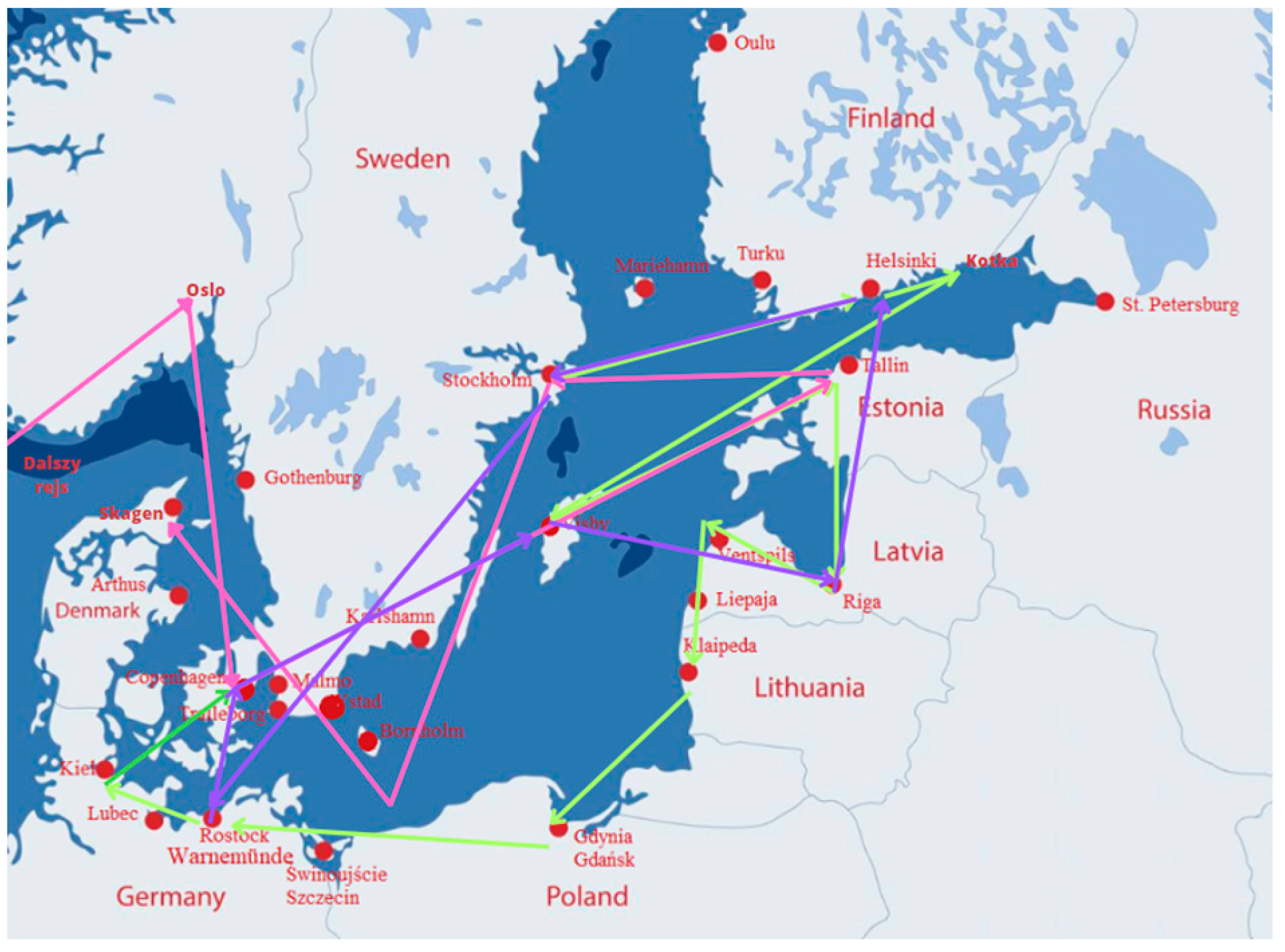



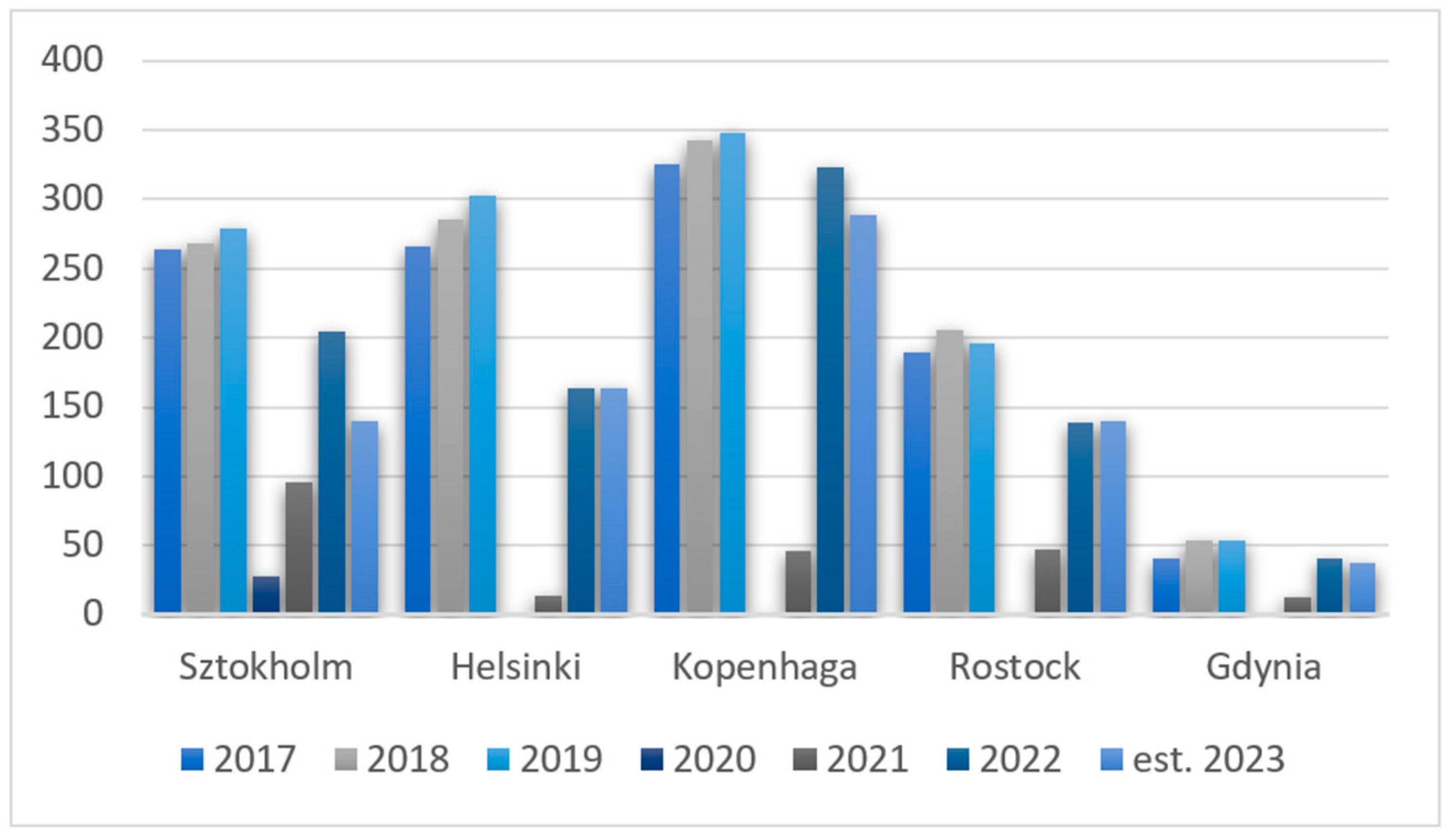
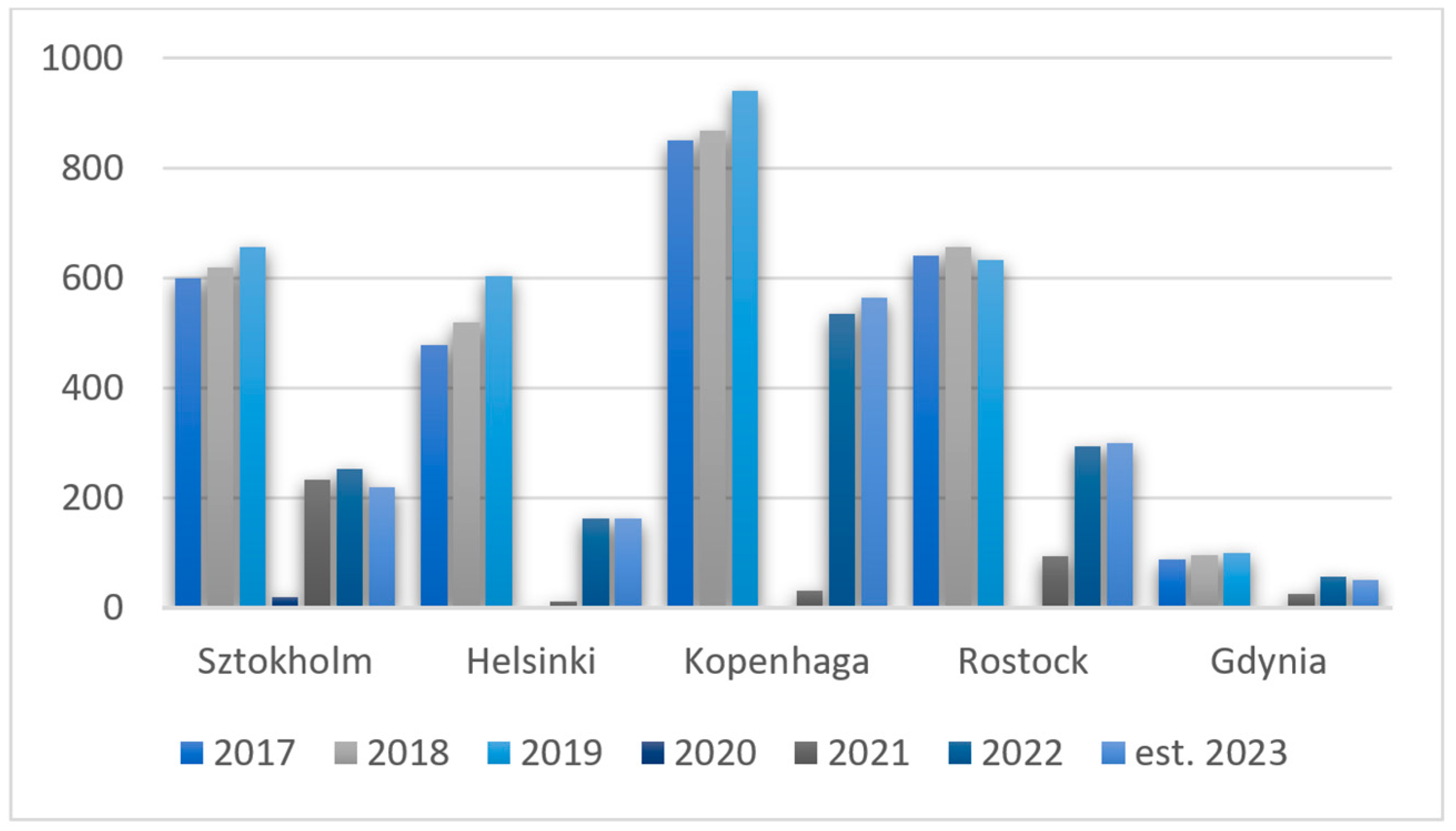
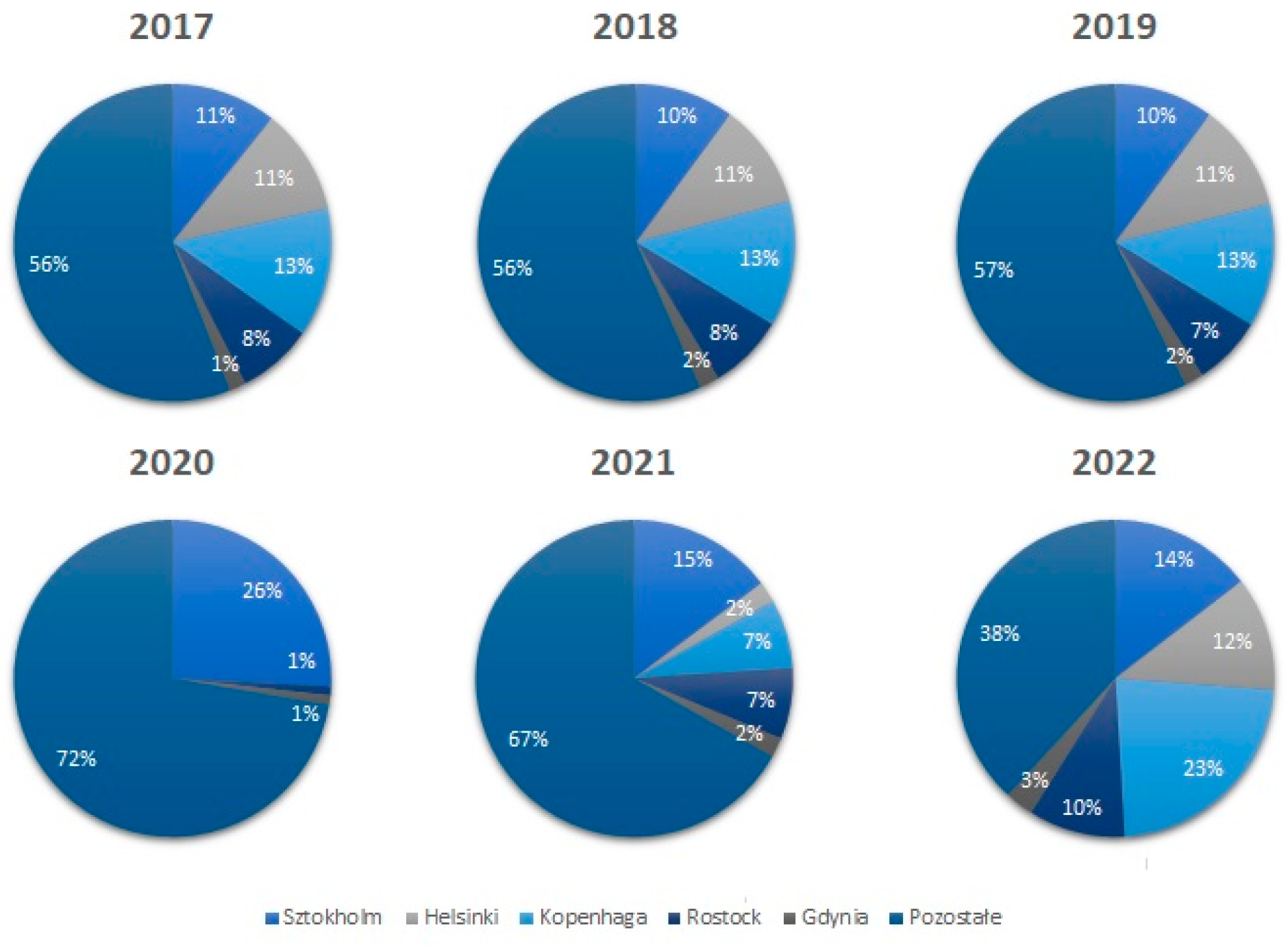

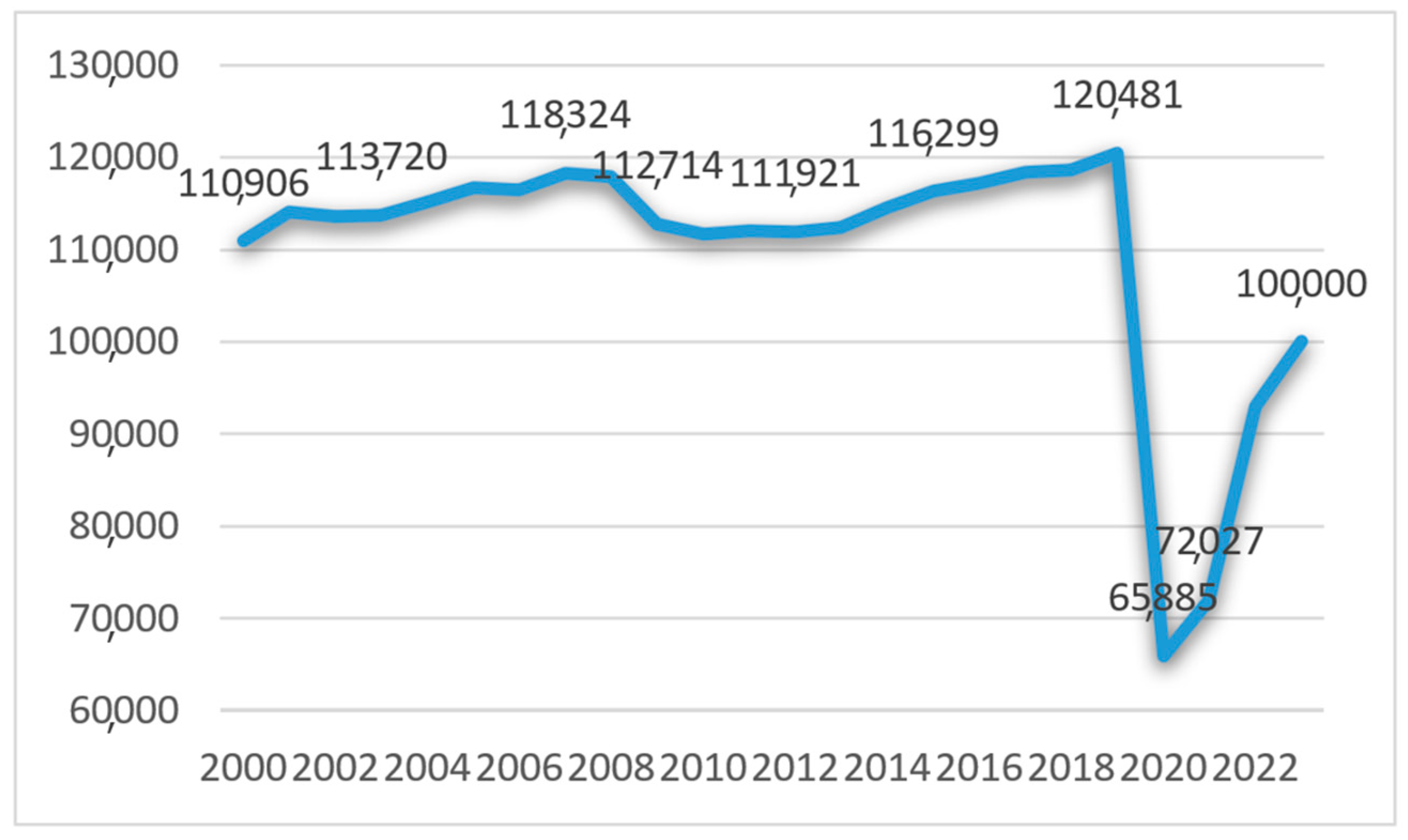
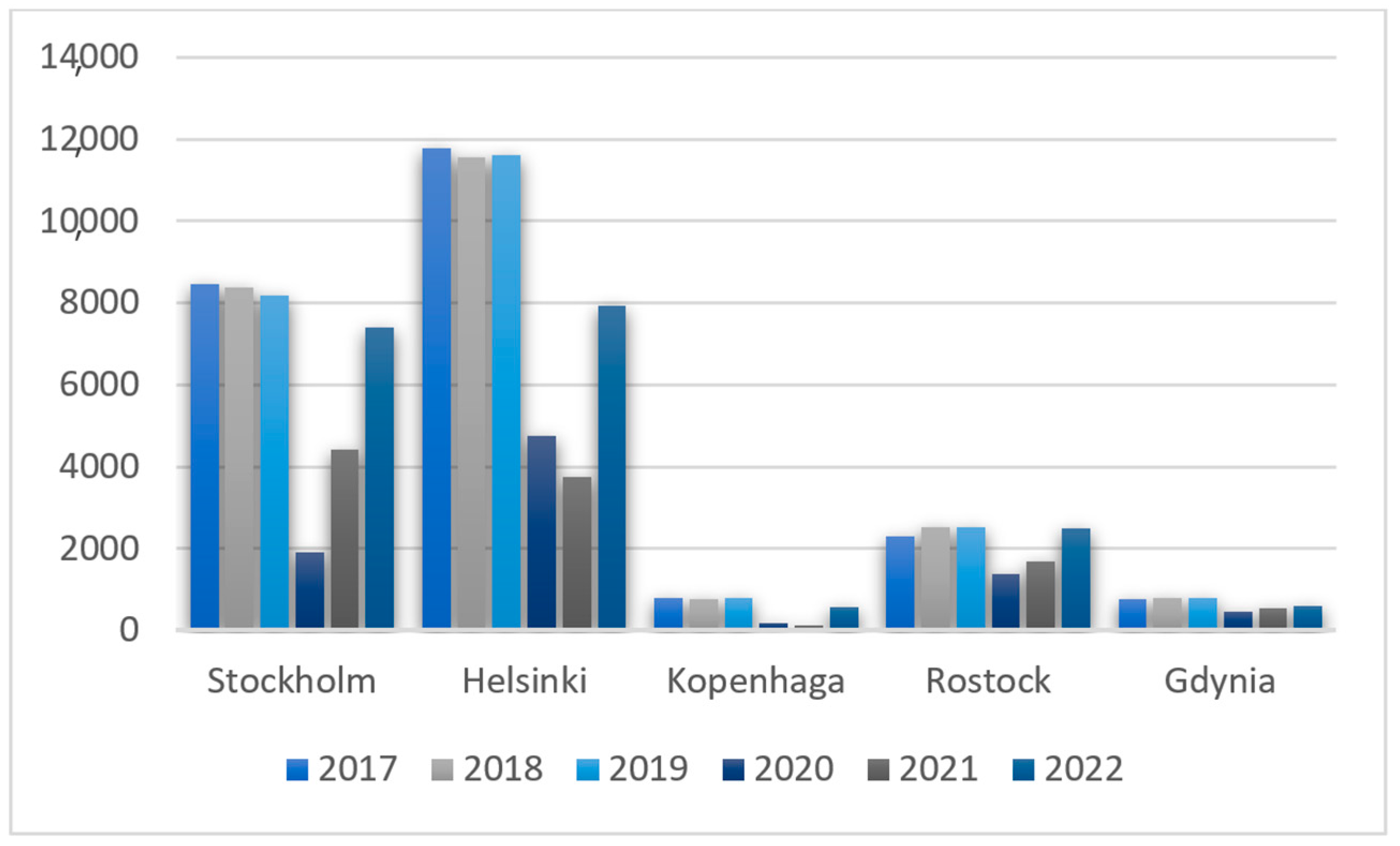
| Category | Value |
|---|---|
| Shore visits by passengers and crew (USD million) | 148.41 |
| Total direct expenditures (USD billion) | 72.02 |
| Total product input (USD billion) | 154.46 |
| Total contribution to income (USD billion) | 50.53 |
| Total employment contribution | 1,166,213 |
| 2017 | 2018 | 2019 | 2020 | 2021 | 2022 | est. 2023 | |
|---|---|---|---|---|---|---|---|
| Stockholm | 264 | 268 | 279 | 28 | 96 | 205 | 140 |
| Helsinki | 266 | 285 | 303 | 0 | 14 | 164 | 164 |
| Copenhagen | 325 | 343 | 348 | 0 | 46 | 323 | 289 |
| Rostock | 190 | 206 | 196 | 1 | 47 | 139 | 140 |
| Gdynia | 41 | 54 | 54 | 1 | 13 | 41 | 38 |
| 2017 | 2018 | 2019 | 2020 | 2021 | 2022 | est. 2023 | |
|---|---|---|---|---|---|---|---|
| Stockholm | 600 | 619 | 656 | 20 | 232 | 252 | 220 |
| Helsinki | 478 | 520 | 603 | 0 | 11 | 162 | 162 |
| Copenhagen | 850 | 869 | 940 | 0 | 30 | 535 | 565 |
| Rostock | 641 | 657 | 634 | 0.2 | 94 | 294 | 300 |
| Gdynia | 88 | 95 | 100 | 0.072 | 26 | 57 | 50 |
| 2017 | 2018 | 2019 | 2020 | 2021 | 2022 | |
|---|---|---|---|---|---|---|
| Stockholm | 8460 | 8377 | 8174 | 1906 | 4425 | 7400 |
| Helsinki | 11,781 | 11,569 | 11,619 | 4756 | 3736 | 7938 |
| Copenhagen | 781 | 775 | 789 | 183 | 133 | 574 |
| Rostock | 2310 | 2516 | 2506 | 1364 | 1689 | 2500 |
| Gdynia | 760 | 803 | 791 | 450 | 527 | 600 |
Disclaimer/Publisher’s Note: The statements, opinions and data contained in all publications are solely those of the individual author(s) and contributor(s) and not of MDPI and/or the editor(s). MDPI and/or the editor(s) disclaim responsibility for any injury to people or property resulting from any ideas, methods, instructions or products referred to in the content. |
© 2023 by the authors. Licensee MDPI, Basel, Switzerland. This article is an open access article distributed under the terms and conditions of the Creative Commons Attribution (CC BY) license (https://creativecommons.org/licenses/by/4.0/).
Share and Cite
Baran, K.; Neumann, T. A Comparative Analysis of Seaports in Terms of the Development of Maritime Tourism in the Area of the Baltic Sea. Water 2023, 15, 3721. https://doi.org/10.3390/w15213721
Baran K, Neumann T. A Comparative Analysis of Seaports in Terms of the Development of Maritime Tourism in the Area of the Baltic Sea. Water. 2023; 15(21):3721. https://doi.org/10.3390/w15213721
Chicago/Turabian StyleBaran, Katarzyna, and Tomasz Neumann. 2023. "A Comparative Analysis of Seaports in Terms of the Development of Maritime Tourism in the Area of the Baltic Sea" Water 15, no. 21: 3721. https://doi.org/10.3390/w15213721







